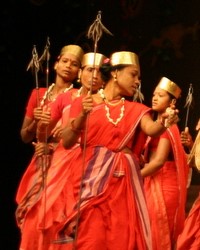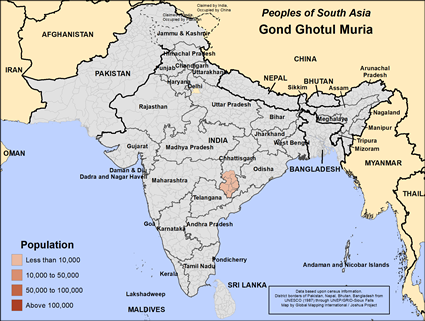Gonds celebrate their legacy every year during the Dasara. On that occasion, all the living heirs of the crown in each generation are honored by carrying them on a royal cart carried on people's shoulders. However, it is uncertain where the Gond people originated. They are probably the largest Dravidian (ie, original tribe in the Subcontinent.)
In the 1500s, there were Gond kings, but they lost their power after being defeated first by the Marathas and then by Muslim armies. However, some of their estates remained for hundreds of years until India's independence in 1947.
Ghotul Muria Gonds live only in the state of Chhattisgarh.
A crude gate on the mud road, the wooden poles on both the sides and the beam across it stands high enough for anyone to enter. There are remains of bundles and ropes hung on it. Among them you may find a new bundle of shrinking animal skin. If you see these before a village, you can be sure you are entering a Gond village.
Ghotul Muria Gonds are agriculturists and choose to live on the riverbeds close to forests. Most of them possess agricultural land. Those who have a good portion of land cultivate rice, grains and green dal. They often tend goats and cattle. Poorer Bison Horn Gonds work in the fields of richer Gonds. There is not much work available for them except in farming seasons. They love hunting and wild meats are their favorites.
Girls are married between the age of 13 and 15. Weddings are during the summer. A girl and a boy who fall love are allowed to run away together. Once they return, the Panchayat meet to discuss the terms and conditions of the marriage. Other marriages are arranged by the parents. Depending up on the financial conditions of the families the bride groom's parents have to give the bride's parents some amount of money. Commonly Gond people marry their cousins.
Ghotul Muria Gond people believe that witchcraft and evil spirits are the causes for sicknesses, but they can keep them away through blood sacrifices. They have a high-priest who is responsible for three or four villages; this priest offers sacrifices for every village. The sacrifice will be followed by a social dinner. The sacrificial goat has to give permission for the sacrifice by nodding its head. The people will wait till the animal nods before slaughtering it. The whole village witnesses the sacrifice, but only the men enjoy the dinner made by cooking the sacrificed animal. All the men gather at the riverside to prepare the dinner. White or black palm liquor may supplement the dinner. The sacrifice animal's skin is stuffed with hay and hung on the village gate. This is to frighten the evil spirits and give courage to the villagers.
Ghotul Muria Gonds spirituality stresses family and clan gods. Village priests and heads of households carry out these religious duties, which usually involve more blood sacrifices. Other rituals involve offerings of coconuts, flowers, fruits, colored powder or string.
Improved educational opportunities are needed for the Gond people, as well as improved health care facilities.
Pray for gospel workers to catch a vision for reaching the Ghotul Muria Gond people for Jesus and that in God's sovereign timing their hearts would be open and ready to follow Him.
Pray for Jesus movements to bless extended Gond families so the gospel will spread rapidly among this people group.
Pray for the spiritual lives of the Ghotul Muria Gond people to become fruitful as they follow Christ.
Pray for the lives and culture of the Ghotul Muria Gond people to evidence the rule and reign of the Kingdom of God as they open to the gospel, and for the beauty of Jesus to be seen in them.
Scripture Prayers for the Gond Ghotul Muria in India.
https://travelswithsheila.com/bisonhorn_maria_tribe_1.html
https://peoplegroupsindia.com/profiles/gond/
https://www.britannica.com/topic/Gond
https://www.everyculture.com/wc/Germany-to-Jamaica/Gonds.html
https://www.academia.edu/21877330/_The_Bison_Horn_Muria_Making_it_More_Tribal_for_a_Folk_Dance_Competition_in_Bastar_Chhattisgarh_Asian_Ethnology_Volume_73_Numbers_1_2_2014_201_231
| Profile Source: Keith Carey |











